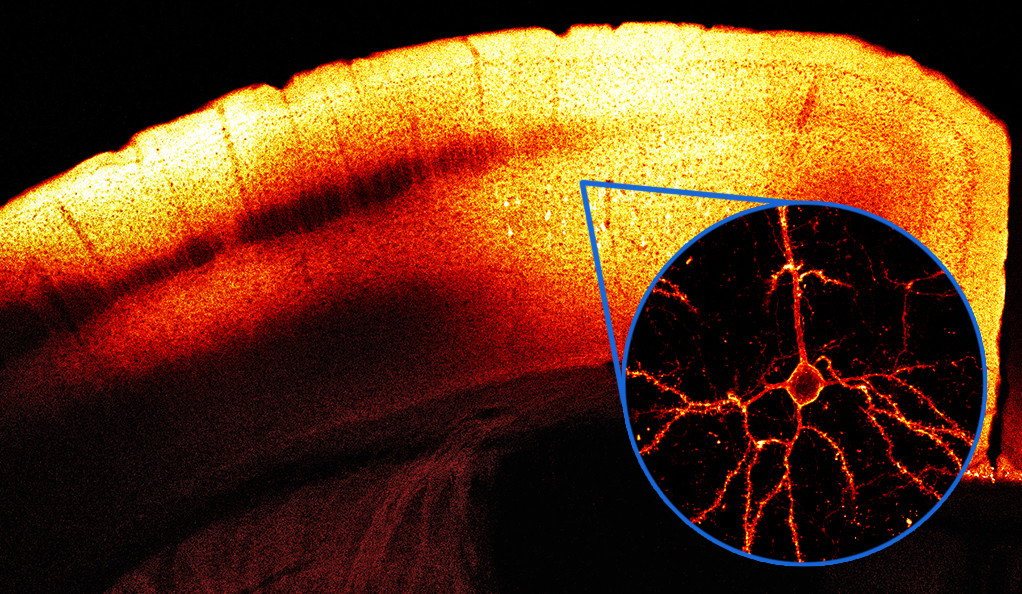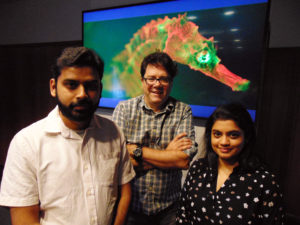
Red voltage indicator VARNAM expressed in the motor cortex of a mouse brain. Inset: a magnified view of a cortical pyramidal neuron showing VARNAM expression at the membrane. (Credit: Madhuvanthi Kannan and Ganesh Vasan; composite by Michael Helfenbein)
![]()
For years, green has been the most reliable hue for live brain imaging, but after using a new high-throughput screening method, researchers at The John B. Pierce Laboratory and the Yale School of Medicine, together with collaborators at Stanford University, have identified a new fluorescent protein that will make it possible for live neurons to glow red when activated. This study was released online today in Nature Methods.
Click here to read full paper.
This Voltage-Activated Red Neuronal Activity Monitor — or VARNAM for short, which means “hue” in Sanskrit — is part of a family of proteins called genetically-encoded voltage indicators (GEVIs), which change their fluorescence intensity when an electrical impulse shoots through a live neuron.
“While green fluorescent proteins have been worked on for over 50-60 years and tailored for a plethora of applications, red fluorescent proteins are newer, fewer, and notorious for folding poorly inside living cells,” said Madhuvanthi Kannan, co-first author and associate research scientist. “We went through several different red fluorescent proteins to find one with optimal photophysical properties that could express and perform well in many different living systems.”
Ganesh Vasan, co-first author and associate research scientist, explained that the automated screening approach he established allowed them to identify VARNAM. The high-throughput approach made it possible to screen thousands of potential red fluorescent proteins and select the most voltage-sensitive among them — the brightest and fastest to appear when a neuron is activated — in an efficient manner.
Previously, red fluorescent indicators had been too slow or too dull to be useful for researchers who are observing the functioning brain. Additionally, when experimenters wanted to watch two different groups or types of cells in action, they could not tag them with more than one color GEVI at the same time. The team not only demonstrated that VARNAM works in multiple systems, both in vitro and in vivo, but also used VARNAM to capture brain activity spikes in live flies in two hues — green and red — for the first time ever.
Now, with red in the mix, scientists will be able to monitor the full “read-write” process of live neurons accurately and easily, said the researchers.
“The development of this probe represents another triumph in the field of directed evolution, honored this year with the Nobel Prize for Chemistry,” said senior author Vincent Pieribone, professor of cellular and molecular physiology and of neuroscience at Yale. “VARNAM represents a significant advance in our ability to directly monitor the electrical activity of brain cells in a less invasive and more comprehensive manner. This opens the door to ultimately understanding how complex nervous systems produce the elaborate behaviors that are the hallmark of advanced human and animal life.”

Authors (left to right): Ganesh Vasan, Vincent Pieribone, Madhuvanthi Kannan of The John B. Pierce Laboratory and Yale University present their findings in Nature Methods, now available online.
This study was funded by grants from the National Institutes of Health.
Other authors on this study include Cheng Huang, Simon Haziza, Jin Zhong Li, Hakan Inan, and Mark Schnitzer from Stanford University.
This study appears online in Nature Methods.
Media Contacts:
Author: Kendall Teare: kendall.teare@yale.edu, 203-836-4226
Social Media: John Buckley: jgb@jbpierce.org, 203-562-9901

